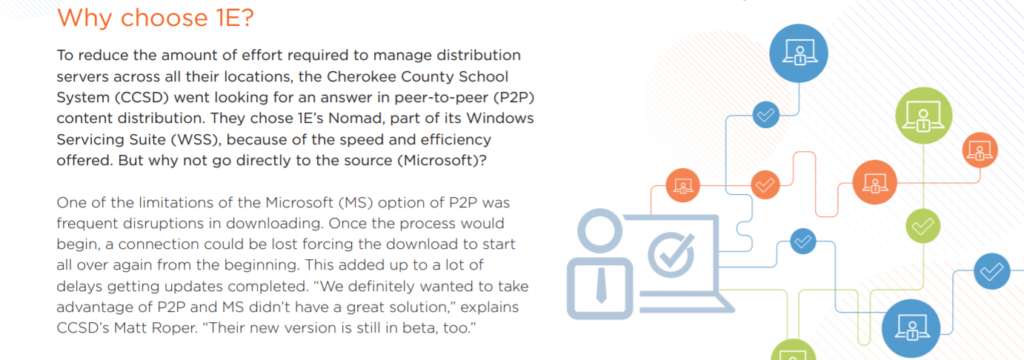It had been a while since I attended and participated at MMS and I find that Microsoft, vendors, and the greater market have been busy. Maybe too busy. It used to be there was just two options for optimizing systems management traffic: Distribution Points and BITS or no Distribution Points and Nomad from 1E. Then along came Pull Distribution Points and some new vendors entered the space.
For a long time, Nomad has been a great way to truly protect your network (compared to just BITS), take advantage of storage on client endpoints and simplify configuration administration. Costly distribution servers are reduced (or eliminated) so that you can deliver content effectively and at any time. Yep. A streamlined infrastructure is no longer considered something unattainable. Now, as part of 1E’s Windows Servicing Suite (WSS) it provides the content distribution and automation support for fully-automated Windows deployment and servicing.
But the game has changed yet again and now there’s content not only from ConfigMgr (CM) but also Windows Update (WU), Windows Server Update Services (WSUS), the Microsoft Store, Outlook, OneDrive, Office 365, Intune, and more. With increased demands on networks for critical Line-of-Business applications and VOIP conferencing, it’s imperative that systems management traffic behaves as a great network citizen. If someone in my network neighborhood has already downloaded something I need or want, why should I download it again? This is true at work or at home. It’s even true in the coffee shop or maybe even the airport. (If you didn't already know, we have a solution for that.)
Today, there are plenty of options for content delivery management and peer-to-peer (P2P) caching. One could argue that there are too many. In an effort to augment and emulate what 1E’s Nomad has been doing for 17+ years, Microsoft has added several technologies and apparently is still working with the formula. Planners must consider and evaluate Peer Cache, BranchCache and Delivery Optimization (DO). Brace yourself—coming soon, yet another option: LEDBAT. This technology for network traffic management has been around for a while, but even that will get the Microsoft touch and come out as LEDBAT++. Each of these only partially addresses the problem and Microsoft recommends using them all in concert to get a reasonably complete solution. Those combinations make troubleshooting ‘interesting’ to say the least.
If you recall our case study with Cherokee County Schools, they used WSS to eliminate servers, transfer content seamlessly, and work their way to Windows 10. In that paper, we described the three different types of technologies: Peer Cache, BranchCache, and DO, our evaluation of each, and demonstrated how WSS saves you time and money.

Based on what we know, what’s the verdict? What’s right for you and your organization? It depends … (#FormerConsultant). If your organization has gone fully “Modern Management only” (and not too many have or can) DO may eventually make sense for you and your org, but it can only be used in very limited scenarios at present.
If, on the other hand, you’re like many of the organizations we talk and meet with – they’re still working to develop and implement a completely unified systems management strategy and are likely to be in a “co-management” scenario for a while. Some systems managed with Configuration Manager and some with MDM/MAM management for their more mobile devices. If that’s you, then Configuration Manager, Intune, and WSS may be the most practical, simple and uniform approach until changes and developments from Redmond continue to develop.
For even more details about efficient peer-to-peer content distribution and OSD for the real world, get in touch, and see Dave Fuller’s blog about Peer Cache options here.




